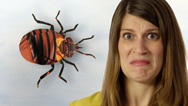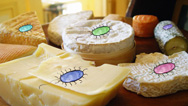The Amazing Barnacle Penis
- Posted 06.25.15
- NOVA
Well-endowed barnacles can change the size and shape of their penises. It’s a great example of something called phenotypic plasticity. Learn more in this episode of Gross Science.
Transcript
The Amazing Barnacle Penis
Posted: June 25, 2015
Here’s everything you wanted to know about barnacle penises but were too afraid to ask. I’m Anna Rothschild, and this is Gross Science.
Listen, barnacle penises are fascinating things.
First of all, they’re gigantic. Certain barnacles have penises that extend 8 times the length of their bodies, giving them the largest penis-to-body-size ratio in the entire animal kingdom. Their sex organs are large for a reason, though. You see, barnacles are sessile creatures, which means that the adults attach themselves to something like a rock or a boat, and then basically don’t move from that spot for the rest of their lives. But, if you can’t move, how do you find a mate? Well, one way is to grow a ridiculously long penis and use it to reach over and inseminate your neighbors. The longer the organ, the more partners you can reach and inseminate.
On top of that, some barnacles can actually change how their penises look based on where they’re living. Pacific Acorn Barnacles that live in calm waters have relatively long and thin penises, while those living in more turbulent waters tend to have shorter, stouter penises. This makes sense from a hydrodynamic perspective, since a shorter, wider, heavier penis would bend less and be easier to maneuver in a rough sea.
The really crazy thing is that if you take a Pacific Acorn Barnacle that’s lived its entire life in a turbulent area, and you transplant it to a much calmer area, that same individual will change its penis size and shape to accommodate its new conditions. This neat trick is a great example of something biologists call “phenotypic plasticity,” which is the ability to change your physical traits in response to the environment.
I realize my enthusiasm about barnacle penises might sound a bit immature, but I’m in good company. Charles Darwin wrote extensively about barnacles and their reproduction, and he too was wowed by the size of their penises.
Ew.
Credits
PRODUCTION CREDITS:
- Host, Illustrator, Animator, Editor
- Anna Rothschild
- DP, Sound
- Elizabeth Gillis
- Many thanks to Dr. Chris Neufeld.
- Rural Ragtime A
- Music Provided by APM
IMAGES
- Image of Barnacle Penis
- Courtesy Chris Neufeld
- Chthamalus stellatus
- Wikimedia Commons/MichaelMaggs
- Boat found at Westport on 1/15/14
- Flickr/Department of Ecology State of Washington
- Charles Darwin 1880
- Wikimedia Commons/Elliot & Fry
SFX
- Cockroaches
- Freesound/StateAardvark
(used with permission from author) - Squeak Pack/squeak_10
- Freesound/Corsica_S
- Slide Whistle Down 01
- Freesound/joedeshon
- Slide Whistle Down Fast
- Freesound/joedeshon
- Produced by WGBH for PBS Digital Studios
IMAGE
- (main image: Barnacles)
- ©WGBH Educational Foundation 2015
Sources
Want more info?
Article on phenotypic plasticity and barnacle penises:
http://rspb.royalsocietypublishing.org/content/275/1638/1081
Darwin on barnacles:
http://darwin-online.org.uk/content/frameset?itemID=F339.2&viewtype=text&pageseq=1
Related Links
-

Gross Science
Bizarre stories from the slimy, smelly, creepy world of science.
-

Bacon Bandages Remove Botflies
Everyone loves bacon. Even parasitic maggots that live under your skin.
-

What Lives in Cheese?
What makes cheese so delicious? It's the bacteria, fungi, mites, and maggots living in it.
-

The Mites That Live On Your Face
There are tiny mites eating, laying eggs, dying, and leaking feces on your face.

